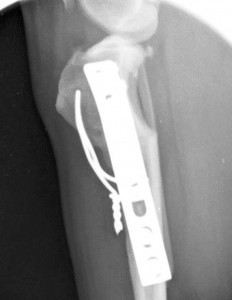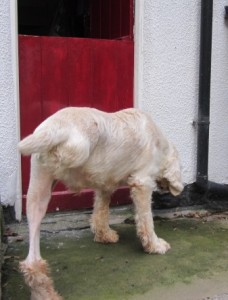Bone, tendons and ligaments respond to stress and pressure by reinforcing and remodelling. They can be tricked into doing this repair and remodeling with the application of ultrasound.
We’ve looked into using sound therapy treatments for enhancing healing in the past, but have shied away from it because these therapies are surprisingly painful, and the frequency of application that is required using very costly equipment wasn’t practical.
But Sonivet is a really neat and simple solution. It uses painless ultrasound rather than audible sound waves, and it is supplied by a unit that is small and cheap enough to be able to easily hire out to owners for daily use at home for a few weeks. The gadget, which fits in your hand, is simply held against the desired area for 20 minutes each day. This could be done with the pet curled up next to an owner while they watch TV! A small area is ideally clipped of hair to mark the target area for the owner, and to facilitate the passage of the ultrasound waves into the body tissues. Gel is applied to the same end.
We hire out the Sonivet gadget for a few pounds a day.
Evidence suggests that bone-healing is about 30% faster with the use of Sonivet.
Our first case was to promote healing after a tibial plating after closing wedge osteotomy to treat cruciate ligament rupture (see separate article in the orthopaedic cases in this section of our website). The owner was heavily pregnant and we wanted the case done and dusted before the waters broke …
The surgery was performed on 29th July. Radiographs 24 days post-op and 37 days post op documented bone healing that was ahead of expectations. So Lilly was “signed off” just 5 1/2 weeks post op, which is earlier than would have been expected; normally these cases aren’t signed off until 8-9 weeks post-op.
We used Sonivet to promote rapid bone healing in a dog called Louis. Louis had had a hind limb amputated 3-4 years ago for a nasty bone tumour called an osteosarcoma. His remaining leg recently suffered a cranial cruciate ligament injury, which was treated with a tibial wedge osteotomy. The need for rapid bone healing in this case is obvious, as the poor lad had to walk on his remaining hind limb straight after surgery.
Another recent case that was thought to benefit from the Sonivet was a distraction fusion cervical vertebral surgery in a Doberman called Buster who had wobbler syndrome and some blood clotting issues. Two of Buster’s cervical vertebrae were held apart with locking plates and bone graft was used to encourage the vertebrae to fuse for a long-term solution. The plates and screws are under a lot of stress and without bone fusion, ultimately they metalwork would be at risk of failure through metal fatigue. So the hope was that the Sonivet would encourage rapid bone healing.
29th July 2014







